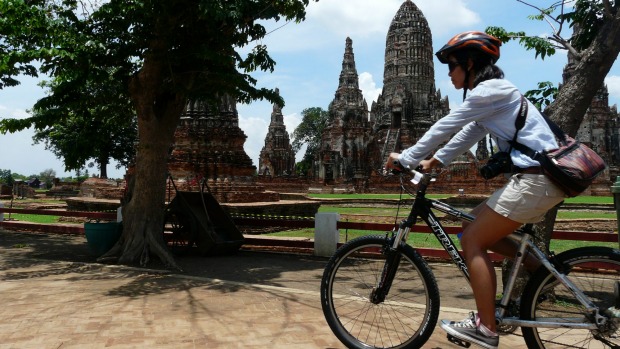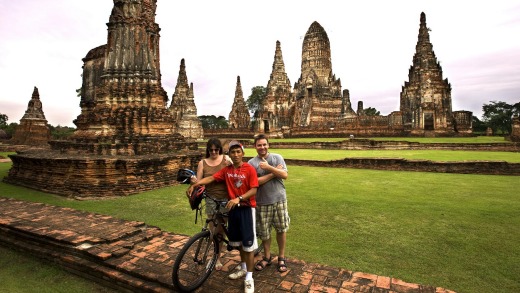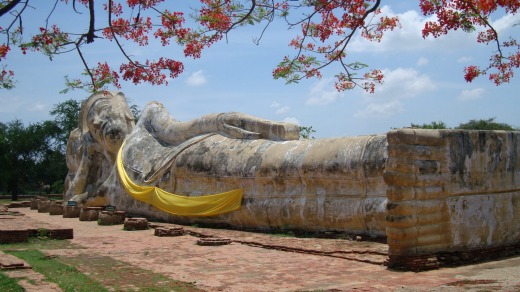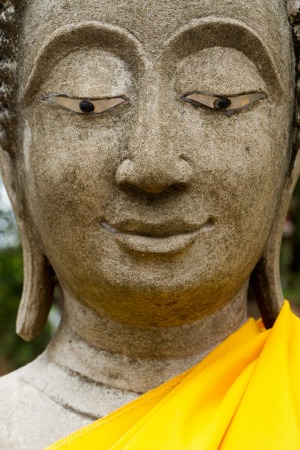
Inside one of Thailand's most important historical sites, among shaven-headed monks lighting incense and offering prayers, an old-fashioned game of pick-up sticks appears to be played by worshippers, over and over again.
In the shadows of Wat Yai Chai Mongkol's towering chedi – so large that it is sinking into Ayutthaya's waterlogged ground – the devout kneel in front of statues of Buddha, gently shaking a container filled with bamboo sticks until one falls out.
Far from child's play, it is yet another way of seeking fortune, each stick bearing a number that corresponds to a slip of paper with a shopping list of fortunes, good and bad.

The first stop on our day-long bike tour of Ayutthaya – Thailand's capital for more than four centuries until the city was attacked by Burmese invaders in 1767 – the ruins typify the city's former significance and beauty.
It also seems a wise move to seek good luck before braving Thai traffic on two wheels even under the watchful eye of SpiceRoads' guides Yo and Por.
Attempt number one fails miserably when I shake out all the sticks and choose one numbered three, which warns: "Conducting activities is ill-intentioned. Wait for favourable circumstances, then success is in sight." My second attempt yields a more favourable fortune, ending with: "Better not rush. Be calm and cool."

That is sound advice for Spice Roads' relatively easy Historic Ayutthaya tour.
The 25-kilometre, largely flat trail begins in Ayutthaya Historical Park, a UNESCO World Heritage site since 1991. It is scattered with weathered layers of burnt bricks that are the remnants of a grand city sacked by the Burmese who rampaged through the ancient capital, slaughtering its inhabitants, setting fire to buildings and looting the city's treasures.
Happily, peace reigns as we wander past endless statues of Buddha – reclining or sitting cross-legged, some dressed in saffron robes, others decorated in gold leaf – and seek relief from the hot sun under bougainvillea and frangipani trees.

Just north of Bangkok and easily accessible by road, or boat along the Chao Phraya River, Ayutthaya replaced Sukhothai as the capital in the mid 14th-century.
The new rulers were ruthless and disciplined, building a regal city of stately palaces, wide moats, stupas and spires (known as prangs).
What the regal builders did not count on was the spongy soils into which their buildings slowly subside. Yo reckons Ayutthaya is Thailand's answer to the Leaning Tower of Pisa.
There are several stupas and prangs tilting at rakish angles at our next stop at Wat Phra Mahatat, its entrance guarded by an ice-cream vendor selling exotic flavours such as pandan, durian and coconut.
We pass bare-footed boy monks more interested in their smart phones than ancient ruins. They're lucky. Yo tells us monks have to abide by 227 rules, while nuns have only eight rules to adhere, including eating only two meals a day.
Shaded by acacia and jujube trees, this site is renowned for a sculpted head ensnarled in tree roots that looks as if it belongs in The Hobbit not ancient ruins.
It is also where our peloton begins our two-wheeled expedition, headed by Yo who confesses his favourite sport is Facebook.
In contrast to the mayhem of Bangkok, Ayutthaya operates at a sedate pace. There is little traffic as we cycle past ancient crumbling city walls, spires pointing crookedly to the sky, moats shaded by red-flowering peacock tail trees and tourists rocking uneasily on top of elephants.
Our next stop, Wat Chai Wattanaram, is on a curve in the river close to one of the churches built by European traders anxious to buy Thailand's silk and spices, precious metals and teak.
Ringed by stalls selling the usual tourist tat (does anyone still buy sequinned elephant bags?), the site is nonetheless peaceful and somewhat eerie given the blackened, headless Buddhas surrounding the large prang in its centre.
Back in the bike saddle, we begin a long stretch away from the crumbling ruins into the countryside, passing rice paddies and villages where children shout out hello and laugh at our exertions.
A mini-van follows us with drinks, snacks and the opportunity to bale from the tour if the going gets too tough. Happily, a light breeze and frequent stops to take photos and drink water make the ride a pleasure.
Lunch marks the halfway point of the Tour de Ayutthaya, where we swap the heat of the road for the heat of red curries and tom yam.
However, with the sumptuous royal palace at Bang Pa-in to visit before its early closing time, we are soon racing towards the finish line at a river crossing.
An hour later, we slide off our bike seats, flushed and drenched in sweat. Yo and Por have barely a hair out of place, let alone unsightly sweat patches, yet they are adamant they felt the heat.
"Thai people can understand the situation when we see western tourists getting hot and sweaty on a bike as Thai people we also have the same experience," Yo says.
"Thailand is a hot country so we can understand this very well."